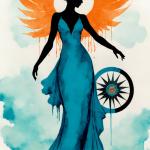Add depth and nuance to your tarot practice by mastering reversals. Learn how to interpret upside-down cards and unlock new layers of insight, enriching your readings and understanding.
In the gentle unfolding of a tarot reading, we sometimes encounter cards that appear upside down. These are what we call reversals. Like the ebb and flow of life itself, reversals offer us a different perspective, a pause for reflection.
There's a certain beauty in how the tarot community approaches these inverted cards. Some embrace them fully, while others prefer to work solely with upright cards. Neither approach is inherently right or wrong; they are simply different paths on the same journey of understanding.
As we explore reversals together, let's approach them with an open heart and a curious mind. They are not here to confuse or frighten us, but to offer a more complete picture of the energies at play in our lives.
What Are Tarot Reversals?
Imagine, if you will, the moment when you're shuffling your deck. Your hands move with purpose, yet with a certain lightness. As you draw a card, you notice it's upside down. This, in its simplicity, is a reversal.
Reversals can occur naturally during the shuffling process, or when we draw and lay out the cards. It's as if the card itself is inviting us to look at it from a different angle, much like how life often asks us to shift our perspective.
It's important to note that the frequency of reversals in your readings often reflects your personal approach and attitude towards them. This relationship between reader and reversals is a spectrum, with various practices along its length:
- Full Embrace: Some readers, recognizing the wisdom and nuance that reversals bring to their practice, intentionally incorporate reverse splits into their shuffling technique. This ensures a balance of upright and reversed cards in their readings, allowing for a fuller spectrum of interpretations.
- Natural Flow: Others prefer to let reversals occur naturally. They might reset their deck after each reading but accept any reversals that appear during the shuffle or draw as significant.
- Upright Focus: On the other end of the spectrum, some readers believe that the deck contains an appropriate card for every situation in its upright position. These practitioners make a point of returning all cards to their upright position after each reading.
Your approach to reversals is a personal choice, one that can evolve with your practice. It's worth reflecting on where you feel most comfortable on this spectrum and being open to how your relationship with reversals might change over time.
Sometimes, the universe seems to have its own say in how a card should be read. Consider this recent experience:
During a reading, the Seven of Cups card was repeatedly blown across the table by the wind, always landing face up but reversed. This occurred four times throughout the reading, while no other cards moved. Such an occurrence might be seen as a strong indication to not only read the card as reversed but to pay particular attention to its message.
In the future position of a reading, the Seven of Cups reversed could signify a period of clarity and focus after a time of confusion or too many choices. It might suggest that the querent will soon be able to distinguish between realistic options and pipe dreams, leading to more grounded decision-making. This card in this position could also indicate a need to be cautious of disillusionment or escapism in the future, encouraging the querent to stay rooted in reality while still nurturing their dreams.
It's moments like these that remind us of the mysterious and often synchronistic nature of tarot reading. They invite us to remain open and attentive to the subtle ways in which meaning can be conveyed through our practice.
Different Approaches to Reading Reversals
Blocked or Stagnant Energy
When we encounter a reversed card, we might consider it as energy that's present but not flowing freely. It's like a stream that's been momentarily dammed – the water is still there, full of potential, waiting for the moment when it can flow again.
For instance, if we draw the Ace of Wands in reverse, it might be gently suggesting that our creative energy is present but perhaps not fully expressed yet. It's an invitation to look inward and see what might be holding this energy back.
Opposite or Weakened Meaning
Another way to approach reversals is to see them as a softening or shift in the card's usual energy. It's not so much an opposite as it is a different shade of the same color.
The Sun card, when upright, often speaks of joy and vitality. In its reversed form, it might be asking us to find that same joy in quieter, more internal ways. It's a reminder that even on cloudy days, the sun is still present above the clouds.
Internalization or Reflection
Reversals can also invite us to turn our gaze inward. They gently suggest that the energies of the card are being processed internally rather than expressed outwardly.
Consider the Queen of Cups. Upright, she often represents nurturing and emotional support for others. Reversed, she might be reminding us of the importance of nurturing ourselves, of filling our own cup before we can truly be present for others.
Delays and Obstacles
Sometimes, a reversed card might indicate that the energy of the card is present but meeting some resistance. It's not a permanent blockage, but rather a pause in the natural flow of events.
The Chariot in reverse, for example, might be suggesting that our journey is still ongoing, but perhaps at a different pace than we expected. It's an invitation to find peace in the present moment, even as we move towards our goals.
Deciding Whether to Use Reversals
Choosing to work with reversals is a personal decision, much like choosing a meditation practice that resonates with you. There's no inherent right or wrong choice; there's only what feels authentic and helpful in your practice.
If you decide to incorporate reversals, you might find that your readings take on additional depth and nuance. It's like adding another dimension to your understanding of the cards.
If you prefer to work with only upright cards, that's perfectly valid too. The wisdom of the tarot is accessible in many ways, and the most important thing is that your approach feels true to you.
Interpreting Reversals in Context
In a tarot spread, each card interacts with the others, creating a tapestry of meaning. A reversed card in this tapestry asks us to pay special attention to its place and its relationships with the other cards.
As you interpret reversals, allow your intuition to guide you. There's a quiet wisdom within each of us that recognizes truth when we encounter it. Trust in this inner knowing as you work with the cards.
Practical Exercises for Mastering Reversals
Daily Reversal Draws
Begin each day by drawing a single card, allowing it to fall as it may. Sit with this card for a moment, whether it's upright or reversed. Notice your first impressions, the feelings it evokes. This practice can become a gentle way to set the tone for your day.
Single Card Reversal Practice
Choose a card and spend some time with it, both upright and reversed. Notice how the energy shifts, how the message changes. This intimate exploration of a single card can deepen your understanding of its full spectrum of meanings.
Reversal Spreads
Create spreads that intentionally incorporate both upright and reversed positions. This can offer a more balanced view of a situation, acknowledging both the apparent and the hidden aspects.
Storytelling with Reversals
Allow a story to unfold through a series of cards, both upright and reversed. This practice can help you see how reversals contribute to the ebb and flow of a narrative, much as challenges and pauses contribute to the richness of our life stories.
Advanced Techniques for Working with Reversals
As you become more comfortable with reversals, you might find yourself naturally integrating them with other spiritual practices. This integration can lead to profound insights and a deeper understanding of yourself and the energies around you.
Reversals can be particularly powerful for shadow work, gently illuminating aspects of ourselves that we might not always see clearly. This work, while sometimes challenging, can lead to great personal growth and self-awareness.
Common Challenges and How to Overcome Them
It's natural to sometimes feel overwhelmed when working with reversals. When this happens, take a deep breath and remember that each card, whether upright or reversed, is an opportunity for understanding and growth.
If you find yourself struggling to maintain a positive outlook with multiple reversals, try to see them as gentle redirections rather than roadblocks. Every challenge carries within it the seed of an opportunity.
Building confidence with reversals is a journey. Be patient with yourself as you learn. Each reading, each interpretation, is a step on this path of understanding.
As we come to the end of our exploration of tarot reversals, remember that they are simply another tool for deepening our understanding of ourselves and the world around us. They invite us to look at things from a different angle, to consider what might not be immediately apparent.
Your journey with the tarot is uniquely yours. Allow it to unfold naturally, embracing both the clarity of upright cards and the gentle questions posed by reversals. In this balance, you may find a fuller, richer understanding of the wisdom the tarot has to offer.






